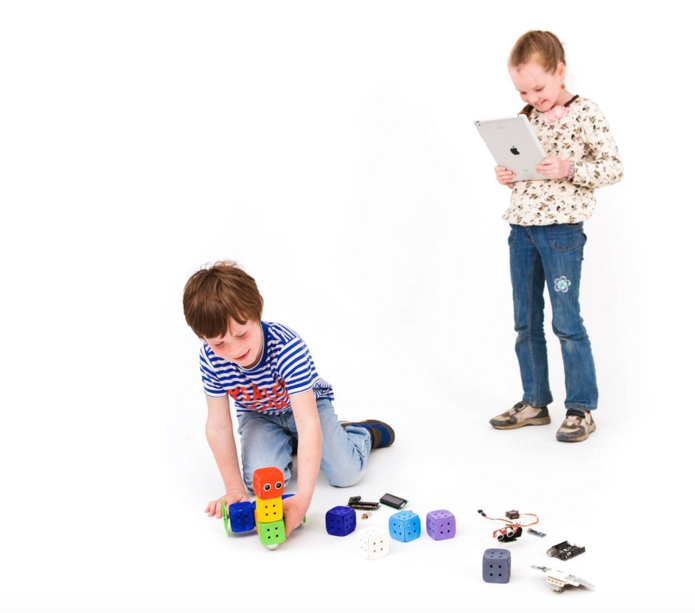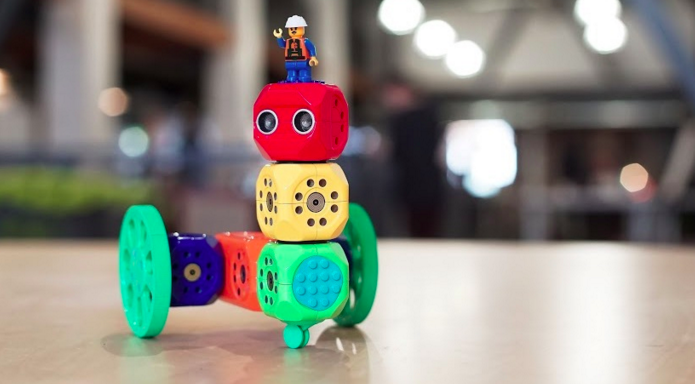The Robo Wunderkind is a modular building system that allows children (and grownups--because, frankly, it's fun) to learn coding basics while igniting a love of making. Inventions like the Robo Wunderkind go a long way toward piquing interest in STEM. We spoke with the COO of Robo, Anna Iarotska, to get her take on why Robo Wunderkind is so ingenious.
Lego has recently skyrocketed in popularity (the Lego Movie, etc.) and now Wunderkind is capitalizing on our love for Lego. Why do you think we’re all so suddenly crazy about building blocks?
Modularity encourages playing and construction sets have always been among the most popular kids’ toys. We are bringing the modular approach into the 21st century by increasing the intelligence of the blocks. Robo Wunderkind’s colorful robotics kit lets kids build their very own robots while picking up coding skills.
Robo Wunderkind has been designed so that flat adaptors can be attached, making the blocks compatible with LEGO®. Children can then personalize the robots they have built with LEGO® blocks or figures.
Each of your modules comes with a processor, WiFi, mic, speaker, and storage. How did you decide on the hardware for each module and which brands are you using?
Last year we spent 6 months in Shenzhen, China, as part of the worldwide first hardware accelerator HAX. Being in close proximity with manufacturers and being able to receive their feedback on our prototypes has helped us decide on the electronics we are using. To name one of the brands, we are using Allwinner A13 SoC in our system module.
The Wunderkind is meant to get kids excited about robots and processing, but how can adults utilize them as well? What’s the coolest invention you’ve seen so far?
The modularity of Robo Wunderkind allows users to come up with many cool way ways to use it. Probably some funky ways even we, the creators, did not think of. We will provide an API for those who want to build apps of their own for their Robos, so the robot can also be fun to use for an older crowd. We are looking very much forward to seeing what our users will come up with!

How can the Wunderkind keep kids interested in electrical engineering?
We are working on a beautifully illustrated book which would guide kids through building the robot and explain the function of the separate modules. In Robo Wunderkind, all the electronics are hidden inside the cubes, which are distinguished according to color. The cubes’ colors relate to their function: red is a proximity sensor, blue is a motor, orange the main controller, and so on. By building the robot, kids will learn what kind of electronic components are needed for a robot to function.
What have been the biggest hurdles you’ve encountered so far?
This is, of course, a hurdle that all products like ours face. In the end, the main challenges were the connectivity between the cubes. Every building block of Robo Wunderkind contains sophisticated electronics on the inside of a uniform cube shape - no outside parts. Of course, it didn’t necessarily have to be this way, and other companies have found other ways to design their own blocks in ways that they see fit, but for us, we felt it was important to keep the blocks as simple as possible (on the outside, at least). The cube shape is the most intuitive form for children to build with, and creating something that was safe and sturdy was a top priority. We have come up with a system that keeps the blocks together securely and allows kids to attach them in any way they want without sacrificing any of the seamless connectivity between the cubes. In order to make this dream a reality, we needed to put in 2 full years of design and engineering work on our project.
What—in your dream scenario—do you envision for your company’s future? What extensions/improvements would you add?
Our team is full of ideas and we want to design and build the most fun and intuitive learning tools for the 21st century. We want to give every child out there the possibility to help shape the future they will be living in. We've been blown away by the support of our backers and have swept past our two original Stretch Goals. Our next stretch goal: if we reach $300,000 on Kickstarter, we will create a platform where people will be able to share their digital design files for Robo Wunderkind 3D printed accessories. We want to make robotics, coding and 3D printing accessible for kids and adults of all ages!
As a project which is rooted in the open source community, we believe that everyone should be encouraged to create and take further what others have created. We want to foster a community which will contribute to the development of Robo Wunderkind and we can’t wait to see what our community will come up with.
Have the majority of your backers been parents or schools or…?
Many backers are parents buying Robo Wunderkind for their kids. At the same time we are sure that some backers are buying it also for themselves: our Professional kit includes modules with a digital camera, accelerometer, light sensor, laser pointer and so on - possibilities for play and experimentation are limitless!
We also have very strong interest from the education community. We are working on lesson plans and a description of classroom activities to facilitate the use of Robo Wunderkind in the classroom. Our robot will make school learning so much fun!
Why is coding so important for budding engineers to learn?
The basics of coding are important to understanding how machines work. It is like learning the language of machines. But we believe there are a few ways in which coding language differs from natural human language, which make it essential for kids. The first is that while coding resembles human language in terms of syntax and semantics, it is far more rigid in its construction - there’s no cutting of grammatical corners or regional slang. As a result, learning this way of thinking helps kids to train their logical and systematic thinking, while still allowing for the creativity that has brought us stunning mobile apps and beautifully designed webpages.
Second, the demand for skilled coders has been and will continue to increase specifically within particular sectors of the economy which can be more or less quantified. This means that anyone who has a basic understanding of coding from an early age will have an advantage when it comes to learning the necessary skills while will then turn into concrete opportunities later on.
With the increasing interaction between front and back end, it is important now even for programmers to know how to speak to different parts of their team and explain how or why they have done something. By integrating play with coding, we hope that Robo Wunderkind will help develop reasoning and logic skills, but also that these skills will be integrated into a time of play, giving children the opportunity to associate teamwork, social skills and coding all as one unified whole.
There you have it: for less than $150 USD, you can score a complete Robo Wunderkind system that will get your kids excited about coding and engineering. It's a small price to pay for a skillset that pretty much ensures future employment.

